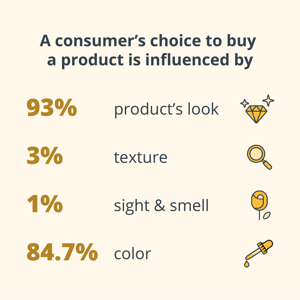While first impressions may not be everything, in a world where there are products upon products to choose from, you want to make sure that your first impression is the strongest and most convincing it can be.
That’s where color psychology can help out.
The colors you use in your marketing have a direct impact on the way your audience engages with your product.
Why, and how can you use that to maximize your sales? Let’s get into it.
What is color psychology?

Color psychology looks at the impact colors have on human behavior.
In the field of marketing, this research focuses on how colors influence brand impressions and sales.
A consumer’s choice to buy a product is 93% influenced by a product’s look, as opposed to 3% texture and 1% sight and smell. 84.7% of consumers say that color can be the sole reason behind purchasing a product.
This means we should be paying particular attention to the way our products look—and especially the colors that we’re using.
Why is that the case?
Well, color evokes particular emotions. Certain colors portray certain inherent messages. In this way, color plays a crucial role in not just how a product is viewed, but also how a brand is viewed.
Some colors can increase the perception of strength and reliability, while others can undermine the values you’re looking to present with your brand.
Red, for example, is associated with passion. Probably not something you’ll want to use if you’re in the funeral industry. But if your business is in summery drinks, then it’ll be a strong choice for you to use.
The meaning behind colors

Let’s unpack the different meanings associated with various colors.
It may change how you feel about your dream logo!
❤️ Red
- Associated with passion, high energy, and excitement. Think McDonald’s using red to excite and engage their target audience—children.
- Here’s a hot tip: Use it for your Call to Action, or your clearance sales.
🧡 Orange
- Cheerful and optimistic, while also associated with caution.
- If red doesn’t work with your color palette, use orange instead to promote sales.
💖 Pink
- Classically associated with femininity, pink has often been used for products for women and girls.
- When using pink, black makes a powerful contrast. Victoria’s Secret does just that to draw women in.
💚 Green
- Green is most highly used in reference to money, nature, and wellbeing.
- If you’re in an industry related to health, fitness, and the great outdoors, you’d be wise to use green. It can help you conjure positive color associations, which you can use to strengthen your brand.
💙 Blue
- Often associated with, and preferred by, men. Blue is also associated with maturity, reliability, and security. Common in the technology world, think of Intel, Skype and HP.
- Using blue in a logo or top navigation can create feelings of trust and reliability for a consumer.
🖤 Black
- Mystery, elegance, and sophistication all come to mind when black is used.
- Black is great for maintaining consistency, especially when contrasted with white.
🤍 White
- White is often associated with cleanliness, purity, and safety. Chanel, Nike, and even Apple use it to promote their brand image.
- White can be paired with blacks and greys to create a clean, neutral look.
Picking the right colors for your brand

Color associations are a good place to start, but there’s more to color psychology.
When picking the right colors for your brand, there are a few more things that should be considered.
Pick a scheme
Start off with picking a scheme.
A monochromatic scheme uses one color in different shades and hues, providing a clean, simple look.
A complementary scheme uses two colors on opposite ends of the color wheel (blue and orange, red and green). It’s common, pleasing, and easy to use.
Alternatively, you can use a triple color scheme, which uses three colors that are equally spaced from each other on the color wheel (green, orange, purple).
After picking a scheme, you can select the colors you’d like to work with. Here are a few questions that’ll help get you there:
- Which color is appropriate for my product?
- Which colors align with my brand personality?
- Which colors appeal to my audience? Consider gender: women are more receptive to softer colors, whereas men react more to bolder hues.
- Do these colors encourage action? Consider whether the colors you use on your branding complement or contrast each other. For example, if your website is in blue, consider making your “purchase now” (or your version of it) red, so that it will encourage action through drawing attention.
When answering these questions, keep a pen handy and jot your answers down. Knowing which colors you have to work with will make your color psychology journey easier.
Once you’ve chosen your colors, you can work to maximize them.
A final parting tip? Contrast.
Contrast is your best friend!
It focuses your reader’s attention, giving you a great opportunity to sell them your product.
However, you don’t want to overwhelm them: keep some parts of your website in high contrast, but not all of it.
Try to find the balance between light on dark, and similar tones.
Using color to make decisions in your branding
When optimized, color psychology can be highly useful in attracting and keeping customers.
Although which colors should be used depends on your brand, what you’re hoping to achieve, and timing, taking the time to research both the colors and your product’s context will boost your sales and get you on the road to success.


